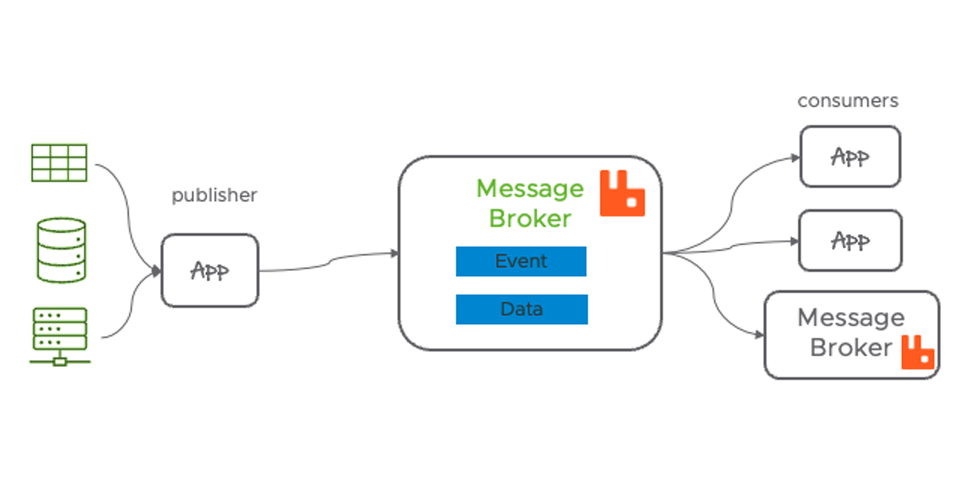
In today’s rapidly evolving digital landscape, real-time data processing and communication hold paramount significance for business prosperity. Irrespective of whether you’re managing financial transactions, IoT devices, or overseeing extensive applications, the necessity of efficiently exchanging data among distinct system components is undeniable. This is precisely where message brokers come into play. In this blog post, we’ll delve into well-regarded message brokers like Apache Kafka, RabbitMQ, Apache ActiveMQ, Amazon SQS, Apache Pulsar, Microsoft Azure Service Bus, Google Cloud Pub/Sub, and NATS. However, before we proceed, let’s begin by addressing two fundamental inquiries: What constitutes a message broker, and what prompts the utilization of message brokers?
What is a Message Broker?
A message broker serves as a pivotal component within contemporary software architecture, meticulously engineered to facilitate communication and data interchange among diverse elements of a distributed system. Picture it as the postal service for your applications, a conduit that accepts messages (data) from one application segment and adeptly directs them to another, ensuring precise conveyance of pertinent information while upholding reliability and efficiency.
A simplified dissection of message brokers’ operation unfolds as follows:
- Producers: These entities or applications generate and dispatch messages. They operate independently of who will consume the messages or the precise mode of processing.
- Message Broker: The central hub within the communication ecosystem. It accepts messages from producers and expertly manages their dissemination to the appropriate consumers, guided by pre-defined rules or patterns.
- Consumers: These serve as the recipients of messages. They subscribe to specific message types or channels and receive relevant messages from the broker. Analogous to producers, consumers operate oblivious to the message origin.
Why Use Message Brokers?
Now that we possess a foundational understanding, let’s unravel the compelling motives underpinning the adoption of message brokers:
1. Decoupling and Loose Coupling:
Message brokers underpin a decoupled architecture, granting producers and consumers operational independence. This disentanglement affords an unparalleled degree of flexibility and scalability to the system. Components can be seamlessly incorporated or withdrawn, sans disrupting the overarching system.
2. Asynchronous Communication:
Message brokers champion asynchronous communication, where producers and consumers operate irrespective of each other’s temporal rhythms. This proves invaluable for crafting responsive, non-blocking systems, an invaluable asset in scenarios characterized by fluctuating processing times.
3. Load Balancing:
Within distributed systems, equitable workload distribution is imperative to thwart bottlenecks and ensure optimal performance. Message brokers proficiently disperse messages across multiple consumers, achieving efficacious load equilibrium.
4. Data Transformation:
Message brokers can adeptly perform data transformation tasks, encompassing message enrichment or translation, prior to message delivery to consumers. This centralized data processing logic simplifies the development of intricate systems.
5. Fault Tolerance:
Message brokers often proffer features such as message persistence and replication, conferring resilience even in the face of system failures. This amplifies system dependability and fault tolerance.
6. Scalability:
Message brokers demonstrate prowess in handling substantial message throughput, rendering them tailor-made for applications necessitating horizontal scaling to accommodate escalating workloads.
Now that we’ve established the pivotal role of message brokers, our journey continues with a comprehensive exploration of preeminent message brokers, unraveling their distinctive attributes and deployment scenarios.
1. Apache Kafka
Kafka, an open-source distributed event streaming platform, commands repute for its exceptional throughput, fault tolerance, and resilience. It stands as the preferred choice for organizations dealing with vast data volumes and real-time data streaming and analytics.
2. RabbitMQ
RabbitMQ, a resilient open-source message broker, boasts versatility in handling diverse messaging patterns, ranging from simplistic point-to-point communication to intricate publish-subscribe paradigms. Its hallmark lies in its high degree of customization and extensibility, catering to a myriad of use cases.
3. Apache ActiveMQ
ActiveMQ, another open-source message broker, offers support for multiple protocols and messaging patterns. It garners acclaim for its simplicity and user-friendliness, making it an ideal choice for environments necessitating swift development and deployment.
4. Amazon SQS
Amazon Simple Queue Service (SQS), a fully managed message queuing service within the AWS ecosystem, epitomizes high availability, scalability, and durability. It emerges as an impeccable solution for erecting robust and scalable cloud-based applications.
5. Apache Pulsar
Pulsar, a distributed pub-sub messaging platform, garners acclaim for its prowess in low-latency, high-throughput scenarios. It accommodates both traditional pub-sub and queueing paradigms, rendering it adaptable to an array of use cases.
6. Microsoft Azure Service Bus
Azure Service Bus, a fully managed message broker service from Microsoft Azure, embraces a gamut of features, encompassing publish-subscribe, temporal messaging, and dead-letter queues. It emerges as the prime candidate for crafting enterprise-grade applications atop the Azure cloud platform.
7. Google Cloud Pub/Sub
Google Cloud Pub/Sub, a scalable and enduring messaging service seamlessly integrated with other Google Cloud services, stands as the linchpin for real-time analytics, event-driven computing, and large-scale data ingestion.
8. NATS
NATS, a lightweight open-source messaging system, revolves around simplicity and high-performance. It emerges as the quintessential choice for crafting nimble, low-latency, and distributed applications.
In the subsequent segments of this series, we will embark on a deeper exploration of each of these message brokers, dissecting their core tenets, utilization scenarios, and best practices for seamless integration. Stay tuned for an immersive journey into the realm of message brokers, armed with insights on how they can elevate the efficacy of your distributed systems!
Bear in mind that the selection of a message broker should meticulously align with the distinctive requisites of your project. Each message broker boasts its own set of strengths and weaknesses, thus necessitating a discerning approach tailored to your project’s precise demands.
[…] Explore the most popular Message Broker Applications: https://devopstipstricks.com/the-8-most-popular-message-broker-applications/ […]